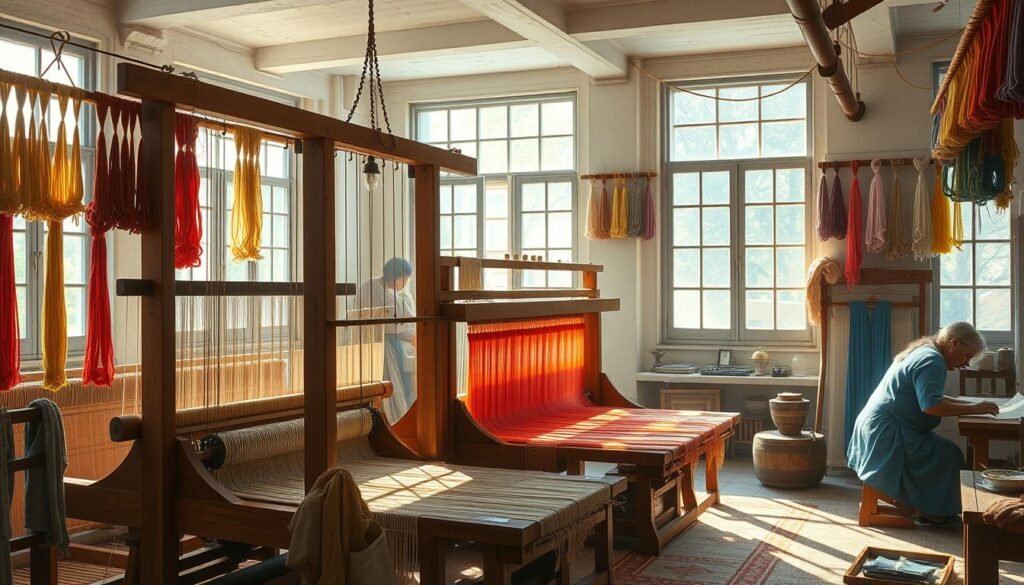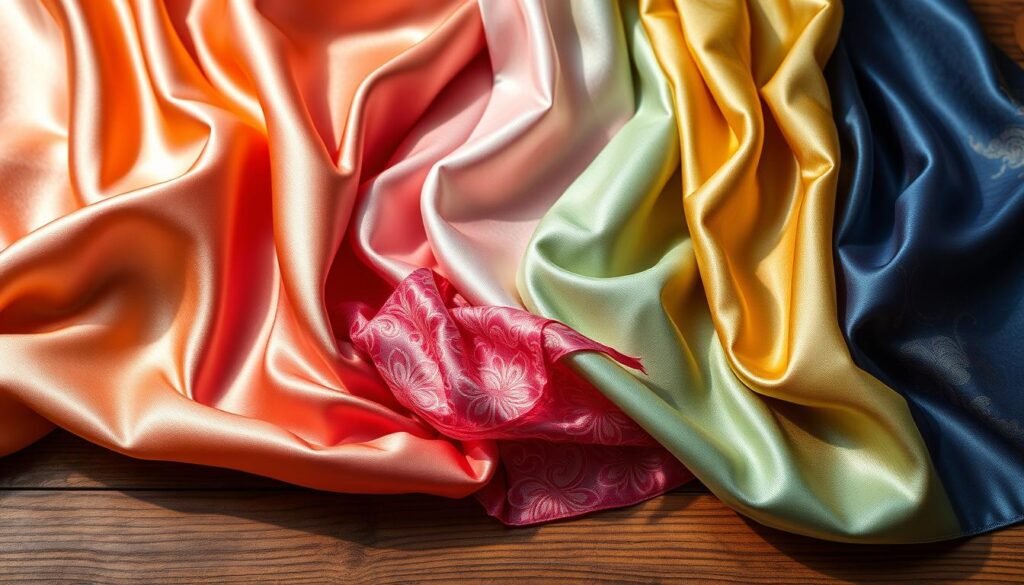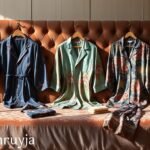Ever wondered how silk goes from a silkworm’s cocoon to the luxurious fabric we all love? The process is quite fascinating, from raising silkworms to weaving the fabric. Let’s dive into the story of silk production.
Key Takeaways
- Silk production starts with raising silkworms. It takes about 8 days for them to make a cocoon1
- Then, silk threads are taken out of the cocoons and prepared for weaving1
- Now, modern silk making uses synthetic dyes and weaving methods for more variety1
- China leads in silk production, followed by India2
- Silk comes in different types like mulberry, eri, and tasar silk2
What Is Silk Fabric?
Silk is a luxurious, natural textile fiber. It is known for its strength, softness, and shiny look3. Silkworms are raised to make silk. They grow, molt, and then make cocoons3.
These cocoons are boiled to get the silk fibers. These fibers are then softened and twisted into threads3. Silk fabric is made by weaving these threads on a loom. This makes different types of silk like satin, gauze, and brocade3.
Silk: The Strongest Natural Textile
Silk is the strongest natural textile, even stronger than man-made materials3. Its shine comes from the way its fibers reflect light3. Silk is loved for its soft feel, breathability, and long-lasting beauty3.
It also takes dye well, making colors last longer and look brighter3.
Origin and History of Silk Production
Silk making started in ancient China, with the first silk found around 6500 BC4. Legends say Empress Leizu made sericulture, the art of silk-making4. Silk spread to other places, creating trade routes like the Silk Road to Europe4.
China still leads in silk production and export, making over 70% of the world’s silk4. Now, the silk industry is moving towards being more ethical and green4.
“Silk is the most luxurious and versatile of all natural fibers, with a unique luster and drape that sets it apart from all other textiles.” – Unknown
How Is Silk Fabric Made?
The silk production starts with raising silkworms, a key part of sericulture. Silkworm eggs are hatched, and the young ones are fed mulberry leaves. This helps them grow and develop5.
Step 1: Sericulture and Silkworm Rearing
After a month, the silkworms make cocoons. These cocoons are then picked. To get the silk fibers, the cocoons are boiled. This removes the sericin, a sticky substance that holds the fibers together5.
Step 2: Harvesting and Extracting Silk Threads
The silk threads are taken out of the cocoons. They are then joined together to make one silk strand. This is a detailed and hard task5.
Step 3: Dyeing and Coloring
The silk threads can be dyed using old or new methods. Natural dyes from fruits or plants, or acid dyes, can be used. This makes the silk come in many bright colors5.
“Silk fibres are harvested from cocoons in their raw state by being boiled in hot water, where the cocoons unravel.”6
Making silk is a detailed and careful process. It needs a lot of attention at every step. From raising the silkworms to dyeing the silk, each step is important. This turns the natural fiber into the luxurious silk we all love.
Spinning and Weaving Silk Threads
The process of making silk fabric starts with silk spinning. First, silk fibers are taken from cocoons. Then, they are laid flat and spun onto bobbins. This gets them ready for weaving. This process can be done by hand or with machines like ring-spinning and mule spinning7.
After preparing the silk threads, the silk weaving starts. The warp and weft threads are woven together. This makes the silk fabric. The way it’s woven can make the fabric look different, like satin or plain weave7.
The quality of silk fabric comes from how the silk thread processing is done. Choosing the best mulberry silk fibers and dyeing them carefully is key. Each step affects the silk’s beauty and strength8.

India and China lead in making silk threads. They have a long history of weaving silk. Different types of silk, like Kanjeevaram and Banarasi, show the skill and culture of these places7.
“Silk is the queen of all fabrics, known for its softness, elegance, and strength. Making silk involves spinning and weaving threads with great skill and art.”
Finishing Processes for Silk Fabric
After weaving silk fabric, it gets special treatments to make it better. These silk fabric finishing steps are key to making silk as luxurious as it is9.
Chemical Treatments and Lustering
Lustering is a big deal for silk. It makes the fabric shiny and glowing. This makes silk very sought after9.
Chemicals also make silk better. They can make it wrinkle-free, fire-resistant, and bug-proof. Stuff like Glyoxal and Citric acid helps silk stay smooth9.
Calendering makes silk smooth and shiny. Hot calendering gives silk a special shine9.
Adding metals to silk makes it heavier. This helps it keep its shape and feel nice9.
Silk needs protection from the sun. So, it gets special finishes to keep it safe9.
The finishing steps for silk are very important. They make sure silk stays as special as it is. Choosing a good silk maker is key for top-notch silk9.
| Finishing Process | Purpose |
|---|---|
| Lustering | Enhancing the lustrous and shimmering appearance of silk fabric |
| Chemical Treatments | Improving properties like crease-proofing, fire resistance, and insect resistance |
| Calendering | Enhancing smoothness, luster, and overall feel of silk fabric |
| Weighting | Compensating for weight loss during degumming and improving fabric properties |
| UV-resistant Finishes | Protecting silk from the harmful effects of UV radiation |
The silk finishing processes are key to making silk special. Picking a trusted silk maker is important for great silk9.
“Silk fabric finishing is an art form that transforms the raw silk into a masterpiece of luxury and elegance.”
Chemicals and silk lustering are just a few ways to make silk stand out. These steps make silk what it is today9.
Where Is Silk Fabric Produced Globally?
China leads in silk production, making about 146,000 metric tonnes each year. This is much more than India’s 28,708 metric tonnes10. Uzbekistan and Thailand also produce a lot of silk10. China is the top silk maker and seller in the world. The US and EU are big buyers of silk from China and India10.
Silk makes up just 2% of the world’s textiles but is very popular for its special qualities and history11. Bulgaria used to be Europe’s top silk maker and exporter for nearly a century. They made 1,200-2,000 tons of cocoons every year from the 1950s to the 1990s11.
Silk started in ancient China, found by Empress Hsi-Ling Shih in 2696 BC10. During the Han dynasty, silk was a big deal for China’s economy10. The Silk Road trade route started in 130 BC, making China a leader in silk10.
| Top Silk Producing Countries | Annual Silk Production (Metric Tonnes) |
|---|---|
| China | 146,000 |
| India | 28,708 |
| Uzbekistan | N/A |
| Thailand | N/A |
Silk spread to Persia in the sixth century and to India during the Gupta period (AD 400-600)10. In the Byzantine Era, monks brought silkworm eggs in 550 AD10. Italian weavers also made silk during the Second Crusade10.
Over time, the silk industry has changed a lot. But China still leads the world in making and selling silk1011.
“Silk, once the exclusive domain of emperors and the elite, has become a global textile that is cherished for its unique properties and cultural significance.”
Different Types of Silk Fabric
There are many types of silk fabric, but mulberry silk is the most common12. Mulberry silk comes from the Bombyx mori silkworm and is the least expensive type13. It makes up about 90% of the world’s silk and is known for being durable and versatile14.
There are different species of silk worms and ways to get the silk14.
Mulberry Silk
14 Mulberry silk comes from silkworms eating mulberry leaves. It makes fine, smooth fabrics. This type is used in many garments.
Eri Silk (Peace Silk)
14 Eri silk is loved by vegans because the silkworm lives. It makes a thick, textured fabric. It comes from Assam, India13. Eri silk is also known for being warm and strong when mixed with wool and cotton.
Tasar Silk
14 Tasar silk comes from forests with moths still inside. It has a homespun look and is often not dyed.
14 Different silkworms and methods make various silk fabrics12. Silk fabrics have three main weaves: plain, twill, and satin12. There are many types of silk fabrics, each with its own look and use12.

“Silk fabrics can be categorized into 3 main types based on silkworm variations, processing methods, and imitation fabrics not made from silk fibers.”14
14 “Momme” (mm) is how silk is weighed, like 100 yards long by 45 inches wide. Higher momme means thicker fabric. Silk gauze is 6 momme, while satin is 18 momme.
In summary, while mulberry silk is the most common, there are many other types of silk fabrics. Each has its own special features and ways of making it. This gives a wide range of choices for fashion and home design.
Applications and Uses of Silk Fabric
Silk is a versatile fabric used in many ways. It’s often found in luxury clothes like dresses and blouses15. Its light, breathable, and hypoallergenic qualities make it a top pick for fashion15. Besides fashion, silk is also used in making parachutes and surgical sutures because it’s strong and fights bacteria15.
Silk is great for home decor too, like curtains and pillows16. It keeps its shape well and is strong. This makes it perfect for many uses16.
Silk is good for people with allergies because it keeps dust mites away15. It also dries fast and absorbs well. These traits make it very useful16.
Most silk comes from mulberry silkworms, but there are other types like Eri and Tasar silk16. Each type has its own special uses and qualities16.
Recently, silk-like fabrics made from polyester or nylon have become more common16. These cheaper options still have some of silk’s best features16.
Silk’s many uses and special qualities make it a favorite in many fields1516.
Caring for and Maintaining Silk Fabric
To keep silk looking great, you must take good care of it17. Silk is very delicate and needs special handling when you clean and store it17. Using the right ways to handle and store it keeps it looking good over time.
Washing silk should be done by hand or by a pro17. Don’t use harsh chemicals or machine wash, as they can harm the silk17. Use a gentle detergent made for delicate fabrics17. Wash it by hand carefully, don’t wring it, and let it air-dry.
Ironing silk is also tricky17. Use a low heat setting or put a cloth between the iron and silk17. This prevents the silk from getting shiny or changing color.
Storing silk right is key to keeping it in top shape17. Keep it away from sunlight and moisture to stop it from fading or getting weak17. Use bags or boxes that breathe and fold it gently to avoid wrinkles.
Follow these tips to keep your silk looking great for a long time17. Silk is soft, safe for sensitive skin, and popular for that reason17. But, it needs extra care to keep its special qualities.
| Silk Fabric Care | Recommended Practices |
|---|---|
| Washing | Hand-wash or dry-clean using a mild, pH-neutral detergent |
| Ironing | Use low temperature or place a cloth between the iron and silk |
| Storing | Keep away from direct sunlight and moisture, fold gently |
Making silk can be hard on the planet, but some are making it better with green farming and saving water17. Silk also breaks down naturally, which is good for the earth17.
If you’re looking for silk alternatives, try polyester, nylon, rayon, or bamboo17. These can feel and look like silk but are stronger, stretchier, and breathe better17.
“Silk is a natural fiber that is hypoallergenic and gentle on the skin, making it popular for those with sensitive skin.”
Learning how to care for silk helps keep your silk items beautiful for a long time17.
Conclusion
Silk has amazed people for thousands of years. It started in ancient China and has changed little over time18. Silkworms make cocoons that become the silk we love19. Making silk is a complex process that includes many steps, from raising silkworms to dyeing the fabric.
Silk is known for being soft, strong, and shiny19. It has been key in global trade and cultural sharing. China is now the top silk exporter18. Even when synthetic materials became popular, silk’s beauty kept it in demand.
Looking ahead, silk is set to grow in the fashion and home decor world20. It’s a natural, eco-friendly choice for clothes and decor. With new ways to make silk and a love for its classic beauty, silk will continue to be important in our lives.
FAQ
What is silk fabric made of?
Silk comes from a natural protein fiber. It’s made by the Bombyx mori silkworm larvae.
What are the unique properties of silk fabric?
Silk is soft, shiny, and light. It’s also the strongest natural fabric out there.
Where did the production of silk originate?
Silk started in ancient China. Empress Leizu made it around 6500 BC.
How is silk fabric produced?
First, silkworms are raised. Then, their cocoons are harvested. Next, silk threads are made and woven into fabric.
What are the different types of silk fabric?
There are mulberry silk, eri silk, and tasar silk. Each type has its own way of being made.
Where is the majority of the world’s silk produced?
China makes the most silk, about 146,000 metric tonnes a year. India, Uzbekistan, and Thailand also produce a lot.
How is silk fabric used in various applications?
Silk is used in fancy clothes, home decor, and even in medical products. It’s very versatile.
How should silk fabric be cared for and maintained?
Wash silk by hand or dry-clean it. Use gentle soaps and avoid harsh chemicals. Store it right to keep it looking good.




